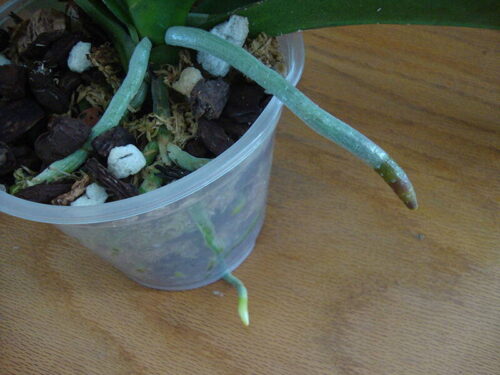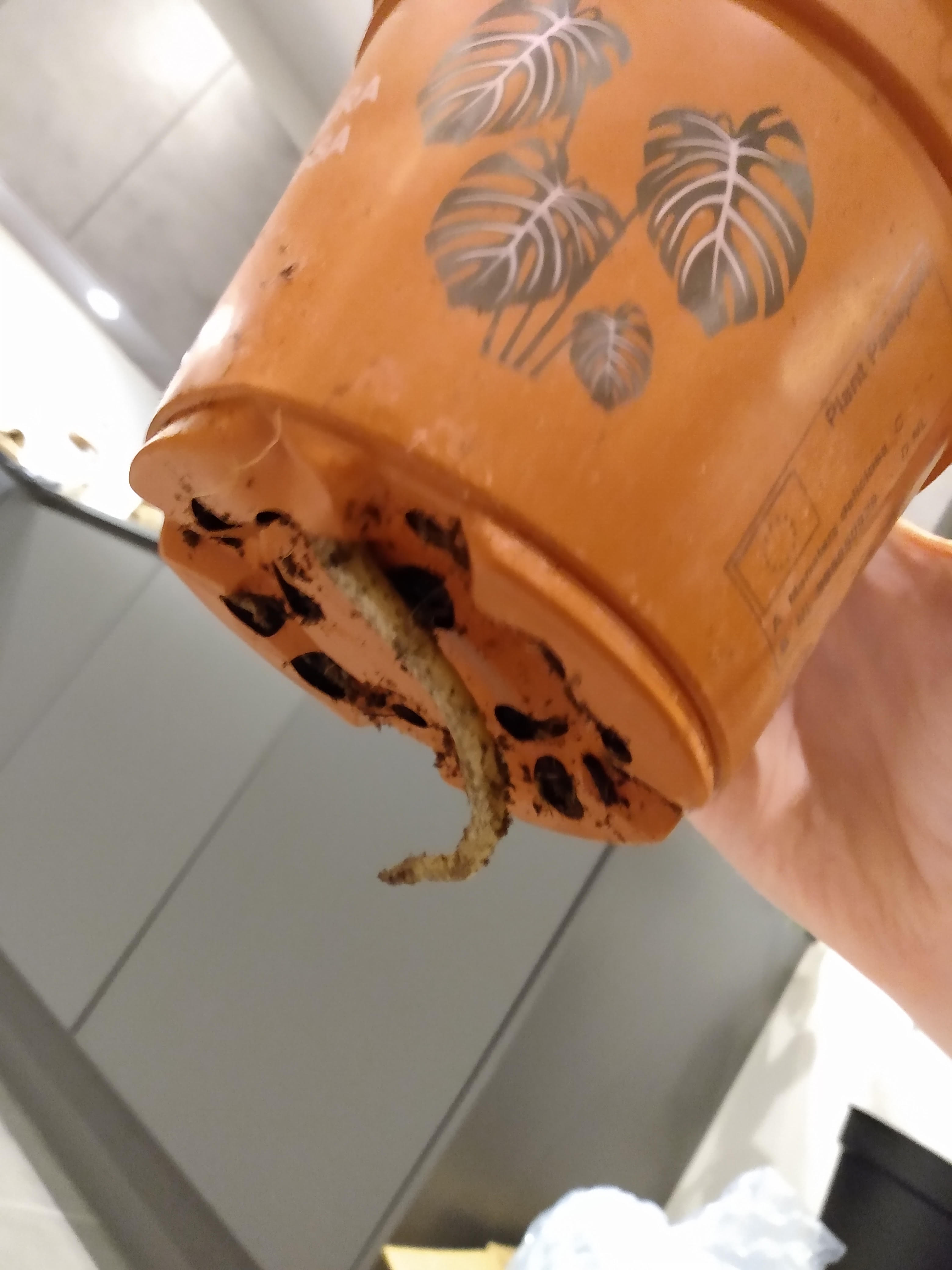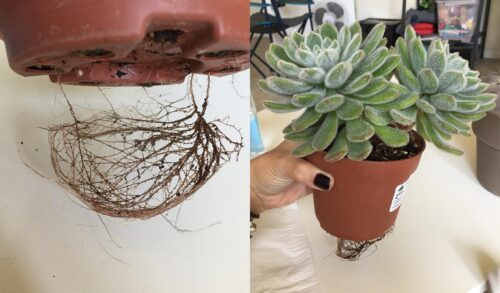If plant roots grow out of pots, it’s best to repot the plant into a larger container to prevent root-bound stress and promote healthy growth. When roots become crowded, it can lead to decreased water and nutrient absorption, hindering the plant’s overall health.
Repotting into a larger container with fresh soil will provide the roots with more space to expand and thrive. Before repotting, gently loosen the roots and remove any encircling roots to encourage outward growth. Once repotted, water the plant thoroughly and place it in a suitable environment with adequate light and proper care.
Regularly monitor the plant’s growth and adjust the pot size as needed to ensure its well-being. By addressing root crowding promptly, you can help your plant reach its full potential and enhance its longevity.

Credit: www.repotme.com
Why Plant Roots Grow Out Of Pots
Plant roots growing out of pots can occur due to overcrowding, nutrient deficiencies, or restricted root growth. If you notice this happening, it’s essential to repot the plant in a larger container, ensuring the roots have enough space to grow and access the necessary resources for healthy development.
Additionally, regular monitoring and proper care can help prevent future root overgrowth issues.
Plant roots grow out of pots due to two main reasons: size limitations of pots and overcrowding of roots. Understanding the causes can help you prevent issues with your potted plants.
Size Limitations Of Pots
- Pots that are too small restrict root growth and cause roots to grow out of drainage holes.
- Ensure your pots are spacious enough for proper root development.
Overcrowding Of Roots
- When roots outgrow the available space, they circle around the pot, leading to root-bound plants.
- Regularly check and repot your plants to prevent overcrowding.

Credit: gardening.stackexchange.com
Signs Of Root Bound Plants
Root bound plants show signs of roots growing out of pots, such as circling around the base and appearing congested. To address this issue, gently prune the roots, repot the plant into a larger container, and ensure proper drainage to promote healthy growth.
Visible Roots Coming Out Of Drainage Holes
If you notice visible roots emerging from the drainage holes at the bottom of your plant’s pot, it’s a clear indication that the plant has outgrown its current pot and is likely becoming root bound. The roots are trying to find more space and nutrients, and when they can’t, they start to escape through the drainage holes.
Slow Growth Or Wilting
Slow growth and wilting are common signs of a root bound plant. When the roots have filled up the entire pot, there is limited space for them to expand and absorb nutrients. As a result, the plant’s growth slows down, and the roots may struggle to provide enough water and nutrients, leading to wilting of the leaves.
Watering Difficulties
Watering difficulties can also indicate a root bound plant. When the roots have taken up most of the space in the pot, it becomes challenging for water to penetrate the soil and reach the roots. This can lead to inconsistent moisture levels in the soil, making it difficult to properly water the plant.
Preventing Roots From Growing Out Of Pots
When plant roots outgrow their containers, it can lead to stress for the plant and negatively impact its health. To prevent roots from growing out of pots, there are several key measures to consider, including choosing the right pot size, proper soil selection, and regular repotting.
Choosing The Right Pot Size
Selecting the correct pot size is crucial in preventing roots from outgrowing the container. Ensure the chosen pot provides ample space for the plant to grow and expand its roots without becoming root-bound. When planting, the pot should be at least 20% wider than the plant’s root ball to accommodate future growth, allowing plenty of room for the roots to spread.
Proper Soil Selection
Selecting the appropriate soil is essential in preventing roots from becoming compressed and entangled. Use a quality potting mix that provides adequate drainage and aeration to prevent waterlogged conditions, which can lead to root rot. A well-draining mix promotes healthy root growth and prevents roots from circling around the pot.
Regular Repotting
Regularly repotting plants is a critical step in preventing roots from outgrowing their containers. As the plant grows, it will eventually require a larger pot to accommodate its expanding root system. Observing the plant’s growth and repotting when necessary will help prevent the roots from becoming overcrowded and encourages further growth.
What To Do If Plant Roots Grow Out Of Pots
If your plant roots are growing out of the pots, it’s essential to repot the plant into a larger container to provide more space for the roots to grow. Carefully remove the plant from the pot, trim the overgrown roots, and transfer it to a new pot with fresh soil.
This will help the plant thrive and continue to grow healthily.
What to Do If Plant Roots Grow Out of Pots: Roots growing out of pots can indicate that your plant has outgrown its current container. Assess the root bound situation, use proper transplanting techniques, and provide appropriate care after transplanting to ensure your plant thrives.Assessing The Root Bound Situation
Examine the roots by gently removing the plant from its pot. If roots are tightly packed, the plant is likely root-bound. Choose a new pot that is 2 inches larger in diameter to give the roots room to grow.Techniques For Transplanting
Gently tease the roots apart to prevent tangling. Add fresh soil to the new pot and place the plant at the same level as it was before. Water the plant thoroughly after transplanting to help it adjust to its new home.Appropriate Care After Transplanting
Place the plant in a location with the appropriate light and temperature. Water the plant when the top inch of soil is dry to the touch. Monitor the plant for any signs of stress and adjust care accordingly. Remember, proper care after transplanting is crucial for the plant’s health and growth.Tips For Maintaining Healthy Roots
Healthy roots are essential for plant growth. When roots grow out of pots, it’s a sign they need more space. Repotting, pruning, or transplanting into a larger container can help maintain healthy roots and promote vigorous plant growth. Keep an eye on root growth and take action promptly to ensure your plants stay healthy and thriving.
Monitoring Root Growth
Regularly monitoring the growth of plant roots is crucial in maintaining their health. Keep an eye out for any roots that start to grow out of the pot. This is a sign that the plant has outgrown its current container and needs to be repotted into a larger one. H3 headings
Pruning And Trimming Roots
Pruning and trimming the roots of your plants is an effective way to prevent them from overgrowing and becoming root-bound. When repotting your plant, gently remove the plant from its current pot and examine the roots. Carefully trim any excessively long or tangled roots using clean and sharp scissors. This will encourage the plant to produce new and healthier roots, promoting its overall growth and vitality. H3 headings
Providing Adequate Water And Nutrients
Water and nutrients are essential for maintaining healthy roots. Ensure that you are providing your plants with adequate water by watering them whenever the top inch of soil feels dry. Avoid overwatering, as it can suffocate the roots and lead to root rot. Additionally, regularly fertilize your plants to provide them with the necessary nutrients for optimal root growth. Using a balanced fertilizer specifically designed for the type of plants you have will help ensure they receive the right amount of nutrients. H3 headings

Credit: www.reddit.com
Frequently Asked Questions For What To Do If Plant Roots Grow Out Of Pots?
Should I Repot My Plant If The Roots Are Growing Out The Bottom?
Yes, you should repot your plant if the roots are growing out the bottom to prevent root binding and promote healthy growth.
Should You Untangle Roots When Repotting?
It’s generally recommended to untangle roots when repotting. It helps promote healthy growth and prevents root binding. Untangling roots allows them to spread out, absorb nutrients efficiently, and establish in the new pot. It’s important to be gentle and avoid damaging the roots while doing so.
What To Do If Your Plant Is Root Bound?
If your plant is root bound, carefully loosen the roots and repot it in a larger container with fresh soil. This will give the roots more room to grow and prevent stunted growth.
How Do You Empty Root Bound Plants Out Of Pots?
To empty root-bound plants from pots, gently tap the pot’s sides to loosen the roots. Carefully remove the plant and prune any congested roots. Replant in a larger pot with fresh soil.
Conclusion
Dealing with plants roots out of pots is crucial. Correcting the issue promptly will help your plants thrive. Repotting, trimming, or root pruning are effective solutions. Remember, a healthy root system is key to a flourishing plant. Keep an eye on your plants for signs of root overcrowding.
